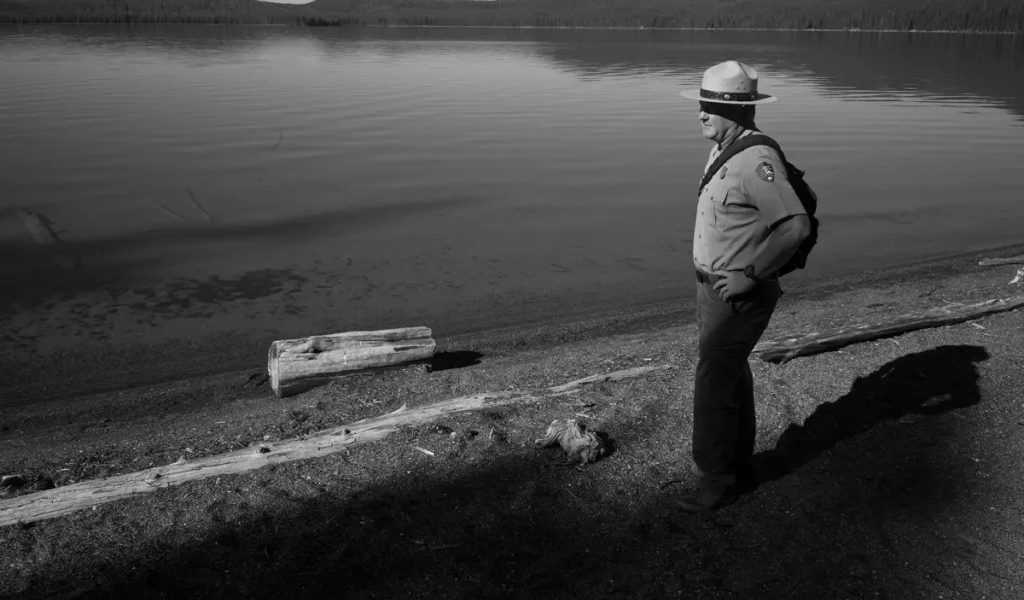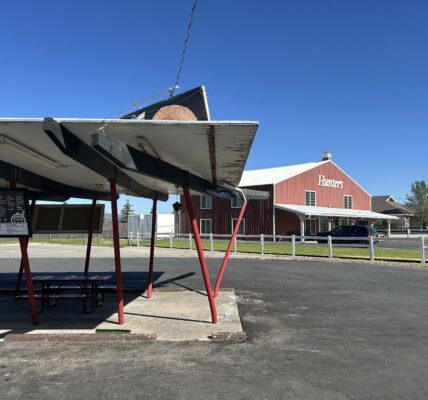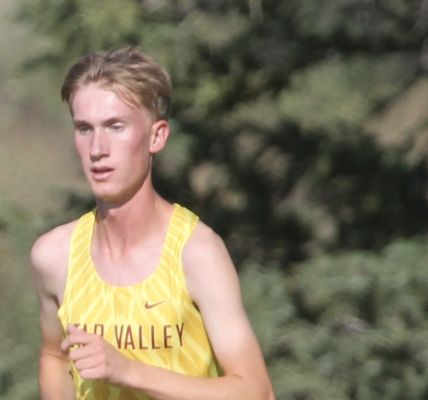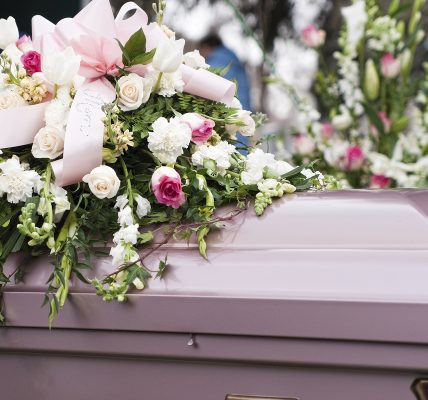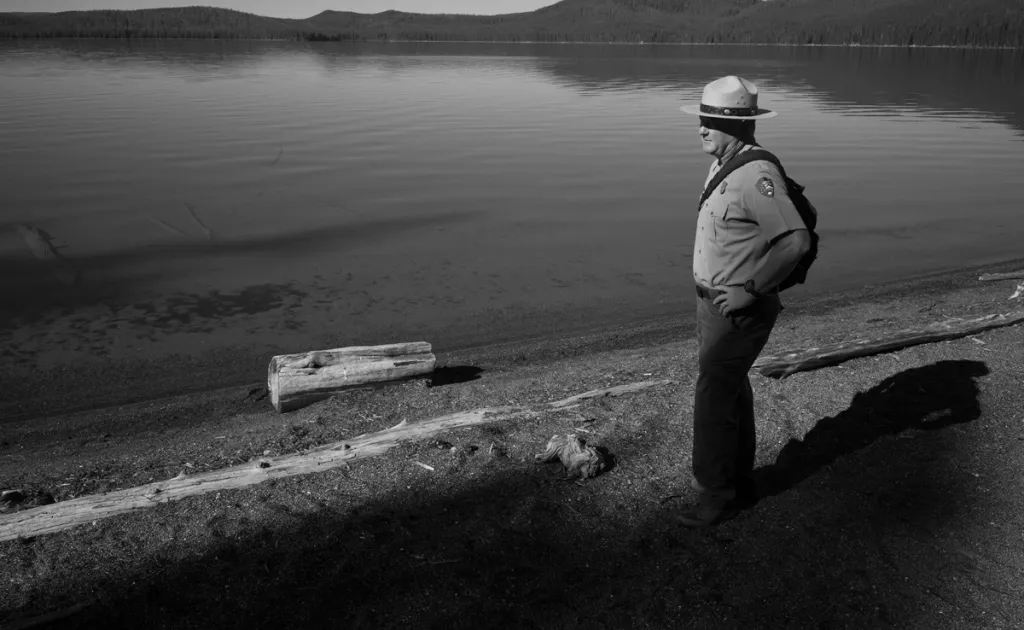
• Two years after a tragedy on Shoshone Lake, rangers reveal details of the search for two lost canoeists, including one who remains missing.
By Angus M. Thuermer Jr., WyoFile.com
SHOSHONE LAKE—Yellowstone National Park Superintendent Cam Sholly strides to the black-sand beach at the north end of Shoshone Lake, pausing in a beam of morning light to absorb the placid tableau. Eight thousand acres of glassy water stretch 4 miles to the lake’s far shore, where lodgepole pine crowd the hillsides. Grizzlies pad among them toward the Pitchstone Plateau.
Sholly sees the glint of damp obsidian flakes at his feet, wind-worn driftwood ashore, even the lake bottom just out from where DeLacy Creek ends its short tumble from the Continental Divide.
What he doesn’t see is any sign of Kim Crumbo, a lifelong paddler, rower and retired Grand Canyon National Park river ranger who was 74 when he disappeared here two years ago.
It is a crisp morning in August. The park is full of summer tourists. Sholly and Chris Flesch, Yellowstone’s starch-sharp chief ranger, have come to the quiet shores of Shoshone to describe, for the first time publicly, the details of Crumbo’s disappearance and the death of his 67-year-old brother Mark O’Neill, another professional waterman and retired Park Service ranger.
It seems improbable that fate would land on Kim Crumbo and Mark O’Neill on Sept. 13, 2021. “Those of us who guided in the canyon with the two half-brothers … are struggling to make sense of the loss,” former Grand Canyon guide Rebecca Lawton wrote two months later in a column for Writers on the Range. “[M]any of us have found it unfathomable that a lake could make ghosts of such men.”
Fifty-nine searchers spent 20 consecutive fall days looking for the men, who had set out on a five-day canoe trip. They found O’Neill’s body on the search’s second day, but in the 18 days that followed, not Crumbo’s.
In the face of winter, Sholly agreed Oct. 8 — a Friday — to pull teams from their wilderness sweeps. But the superintendent couldn’t rest.
“I don’t dream a whole lot,” Sholly says. But that night two years ago he did. Crumbo came to him, angry that Sholly had retreated.
“It was one of those dreams that you have very rarely where you wake up and you’re like ‘That was a real conversation.’”
The next day’s dawn broke cold and messy as Sholly packed a backcountry kit. He left his quarters on Mammoth’s Officers’ Row and struck out for two days alone at Shoshone Lake, looking.
“For whatever reason,” he says. “I felt like I needed to come out here.”
‘The boys’
Crumbo and O’Neill grew up on the water. They became professional watermen and conservationists. They earned honors for their work.
Crumbo, who was a member of the Citizen Potawatomi Nation through his father, swam with barracuda while growing up in Hawaii as part of a military family. He became a Navy SEAL and served two tours in Vietnam, earning a Bronze Star.
In 1971, he traded the mayhem of the Mekong for the more peaceful if tumultuous Grand Canyon of the Colorado River, hiring on as the first guide at Holiday River Expeditions. The job would propel him into the National Park Service ranger corps and on to deep work in conservation.
A decade as a river guide and 20 years with the Park Service made Crumbo part of the patina of the red rock southwest. He published a river runners’ historical guide to the Grand Canyon. Five environmental groups honored his conservation work, which included aiding the reintroduction of the endangered Mexican wolf to New Mexico and Arizona.
At the time he disappeared, Crumbo was working in Utah as wilderness coordinator for The Rewildling Institute, a New Mexico conservation group. Eight months before he vanished, he completed a 50-page report titled America’s Red Rock Wilderness Act. It proposed protection of 8.4 million acres of public land in Utah and included a map showing a wildlife migration route from Arizona to Wyoming. The route had an arrow point at each end. The southern arrow pointed to the Grand Canyon. The northern arrow rested on Shoshone Lake.
Crumbo’s mother Patricia Elliott birthed his brother, Mark O’Neill, in 1954 along with a twin sister Toni.
Elliott had four sons and a daughter from three separate fathers, each of whom slipped from family life early. “They were raised as brothers,” Toni Kelly said. “Never was ‘half’ mentioned, ever.
“None of us remember our dads,” Kelly said. “It was always only mom.”
As a youth, O’Neill was an ocean lifeguard, a skipper, swimmer, surfer and diver. He grew up in Hawaii, Rhode Island, Utah and California.
Like his brother, he rowed as a river guide in the Grand Canyon in the mid 1970s and became a seasonal ranger with the Park Service there. He retired from his last federal post at Olympic National Park in 2016 after 20 years there, earning recognition for a brave river recovery as well as supportive supervision of employees.
The boys, as they were called, both had families and pursued outdoor adventure after their professional careers. O’Neill made two trips across Yellowstone’s Lewis Lake to the non-motorized Shoshone. When Crumbo had to back out of the second one, O’Neill forged on with a solo paddle. He wanted to return for a third time with his brother. “He loved Shoshone,” his wife Karin Lowrie told WyoFile. “He loved being in this remote place.”
In 2021, O’Neill and Crumbo’s reunion happened.
At about 4 a.m. on Sept. 9 that year, O’Neill left Chimacum, Washington, in his Honda Pilot. He headed for Crumbo’s home in Ogden, Utah, from where the two would go on to Lewis and Shoshone lakes, just for fun. He hauled a trailer carrying his canoe, a boat he named after a favorite place.
He called the craft ShoLew.
The gem
At 7,790 feet above sea level and tucked against the Continental Divide, Shoshone Lake is among the headwaters of the Snake-Columbia system. DeLacy, Shoshone, Cold Water and Moose creeks, fed by Pacific storms, fill its 205-foot-deep pool.
Shoshone Geyser Basin at the lake’s west end lures paddlers with its variegated mud pots and boiling pools. It’s the largest backcountry geyser basin in the park. Its fantastic fountains — Minuteman, Union, Bronze and Little Giant geysers — are among more than 50 thermal features. Narrow trails guide hikers through the basin’s fog and steam.
The Crow Tribe believe these waters are powerful and sacred, a place for vision quests. The flows began running out of Yellowstone long, long ago, according to Shoshone and Bannock tales, when the troublemaking trickster Coyote didn’t listen to Mother Earth, stepped on her basket of fish and loosed the Snake and Yellowstone rivers.
Shoshone Lake appeared as “a most beautiful sheet of water, set like a gem among the mountains,” government geologist Fernand Hayden wrote in 1872. It looked heart-shaped to him from his elevated and distant vantage of Craig Pass, but it’s outline is more like a bow tie, a dog bone or dumbbell. Its longest axis is 6.5 miles, in line with the prevailing southwest winds. It’s 4 miles across at its widest, 660 yards across at its waist — The Narrows.
Shoshone is the largest backcountry lake in the Lower 48, Yellowstone says. No roads mar its shores, no motors spoil its silence. A visit requires an expedition. Cell phones don’t work here.
Wilderness venturers spend days camping at some of the 23 sites along its 28-mile shore, each having a primitive latrine and a high cross-timber to hang food out of bears’ 9-foot reach.
Shoshone attracts flotillas of youth groups whose members plan and prepare, then steel themselves against a million mosquitoes as they flay the waters with their fly lines.
Gem as it may be, Shoshone has sharp edges. Before Crumbo and O’Neill’s trip, at least eight people had drowned or died of hypothermia in its chilly waters. Each story is terrifying — men and boys fighting swamping seas and wind. The body of one Shoshone boater, a Casper man lost in 1958, has never been recovered.
Yellowstone rangers count one of their own among the victims. Ryan Weltman, a 22-year-old seasonal ranger, was paddling on patrol in 1994 when waves overwhelmed his kayak.
“The way the lake’s laid out — from the southwest to northeast — that’s going to catch your prevailing winds,” Flesch said. They rake a six-mile fetch, building swells and whitecaps.
“Waves of 3 to 4 feet are common,” a park boating safety brochure reads. “Travel close to shore and in areas protected from wind. Cross only at the Narrows … make any open water crossings in the early morning before winds pick up (around 10 a.m.).”
One danger of such a crossing, should it come to ruin, is hypothermia and subsequent drowning. Shocked by a cold, high-altitude lake, “the brain becomes confused and disoriented, and your arms and legs become numb,” within as few as five minutes the brochure says. Splash gear provides little insulation during immersion. “If you’re not equipped in a dry suit or a wetsuit or something like that, you’re not going to have a lot of time under ideal conditions, let alone inclement conditions,” Fresch said.
Most canoe paddlers, however, don’t dress in dry- or wetsuits on Shoshone Lake. Searchers didn’t find any cold-water protective gear among the brothers’ possessions.
To the park
Crumbo and O’Neill left Ogden on a Sunday, pausing for gas in Jackson Hole, where O’Neill called his wife Karin Lowrie.
“He was light and excited,” she said. “He was in his element … heading into nature with his big brother whom he loved and admired so much.”
The men drove on to Yellowstone’s Lewis Lake Ranger Station and campground. They would collect their four-night backcountry permit, which was to start the next day, Sept. 13. It came with warnings about all the park’s hazards — grizzly bears, boiling pools, cold, open water and high winds. They planned to paddle 4 miles across Lewis Lake and up the Lewis River Channel toward Shoshone. They would slog 2 miles farther up the channel, dragging the ShoLew behind.
At Shoshone, they would paddle west along the south shore toward their first night’s camp. From there they had sites reserved for three more nights.
The Sunday afternoon they arrived, however, they found the popular 84-site roadside Lewis Lake Campground full. Although their backcountry permit wasn’t valid until the next night, weather favored a launch.
“That particular evening was peaceful,” Flesch said. “There was [a] thought that they may have made that trip up to Shoshone that evening.”
The paddlers had more than four hours before nautical twilight, investigators believe, time enough to make an 8-mile trip. A waxing crescent moon over their port bow would have drawn them along.
They set up camp at South Narrow Point.
Seven days later, on Sept. 19, an anxious Lowrie called her sister-in-law, Becky Crumbo, asking about “our adventurers.” Becky Crumbo had heard nothing.
“An alarm within me went off,” Lowrie said.
Yellowstone’s backcountry office handled Lowrie’s call. At Lewis Lake, park staffers located O’Neill’s Honda Pilot and trailer. Michael Curtis, backcountry district ranger for Yellowstone, called out searchers.
One trail crew on the Dogshead Trail to Shoshone Lake dropped its tools and began to comb the outlet area. Curtis dispatched another team down DeLacy Creek to search Shoshone’s east shore from the north.
Given the prevailing winds, “stuff inevitably ends up on that east shore,” he said. “The east shore is our highest probability.”
From the Dogshead work site, Ranger Jonathan Radovich hiked the undulating 4.5-mile trail overlooking the water. Within hours of Lowrie’s alert, he spotted something red.
It was a life vest, a personal flotation device, a PFD. It was empty. A photo shows it on the beach, zipped up. It held a clue, Chief Ranger Flesch said.
“The name Kim was written inside.”

The camp
That afternoon, Radovich and others found more clues — a paddle, a bucket, a drybag and then a canoe. Something had damaged the boat and broken a thwart. The drybag contained retired law enforcement credentials for Mark O’Neill.
Five searchers were in the field that day. “It was miserable,” Curtis said of the search’s start, “snow, wet, rainy.” They sheltered in the Shoshone Lake Ranger Station.
Also known as the Outlet Cabin, the rough-cut A-frame makes a cozy retreat when warmed by its wood-burning stove. The structure’s rustic amenities and a cache of canoes outside have served rangers for decades. Its windows overlooking the water are a wide screen to wilderness drama. It preserves a logbook with lost Ranger Ryan Weltman’s last entry.
“Tomorrow,” he wrote 27 years earlier, “I’ll check the east shore.”
On Sept. 20, 2021 — search-day two — rangers paddled a canoe and kayak from the outlet north up the crenelated shore. They saw a flash of color in a small cliff-ringed cove. One searcher clambered up a bank to look into the recess. He saw a body, face down in the water, one arm draped through the arm hole of an unzipped life vest.
Officials identified O’Neill after rangers flew his body by helicopter to nearby Grant Village. Hypothermia killed him.
The search team expanded rapidly that day. Ensconced at the A-frame and the north-shore Cove Cabin, searchers scoured campsites and the shoreline, most of which is trailless. At South Narrow Point, they found Crumbo and O’Neill’s well-tended but abandoned camp, now dusted with snow.
Trash was hung and so was the food. There were no bear tracks. “Nothing was disturbed,” Flesch said.
One breakfast and one dinner were missing from the food cache, which was organized by meal and by day. The men had spent their first and only night at South Narrow Point, rescuers guessed.
Across The Narrows on the north shore, searchers found another clue — light debris associated with the ShoLew. Rangers figure the debris was set afloat in Shoshone Lake’s west lobe, somewhere between the geyser basin and the camp.
The wind in The Narrows
Rangers can’t say for certain when Crumbo and O’Neill started their trip — whether it was the evening they got to Lewis Lake, Sept.12, or the next day, which was the original plan. One clue came when investigators contacted a backpacker who had hiked to a campsite at Shoshone Geyser Basin on Sept. 13.
From nearby Basin Bay Point that afternoon, the hiker had seen two men in a canoe on the west waters of Shoshone Lake. The paddlers were stroking away from the bay, heading southeast toward The Narrows and South Narrow Point. He took a picture.
“It’s not a great photo,” Backcountry District Ranger Curtis said. Yellowstone can’t identify with certainty the boat or its occupants.
Lowrie believes she can.
“The shape of the canoe and how you ride in it makes me believe it is Mark and Kim and ShoLew,” she said. “Maybe that is my hope because it is a view into their trip, the trip that ended their lives.”
There were myriad ways back to the campsite. The men could have paddled about 4 miles along the north shore and across The Narrows. They could have paddled 5 miles along the south shore. The shortest route is about 3 miles straight across the lake.
Sholly can trace a plausible scenario on a map. “They go down here,” he says gravely on his return to Shoshone’s shore last month, pointing from South Narrow Point to the geyser basin bay. “And then they’re coming back to their campsite and they get beyond this point here.”
His finger aims at the middle of the water.
The backpacker’s picture doesn’t show an angry sea, Curtis says, perhaps because the immediate Basin Bay area is somewhat protected. “You’re not going to start hitting winds until south of that bay, the gut of the lake.”
That’s where the prevailing southwest wind acts on a 2-mile fetch, pushing on toward the constriction of The Narrows, which can become a turbulent bottleneck. The gap between landforms at The Narrows could accelerate wind speeds by 50%, Jackson meteorologist Jim Woodmencey said.
The Narrows, “very quickly amplifies the effects,” Flesch said, creating a crossfire of wind and water.
Storms between Sept. 13 and 16 kept a number of veteran boaters holed up, Flesch said, “with significant whitecaps out on the lake.”
“Storms can be very powerful, and they can come out of nowhere,” Flesch said. “[There’s] very, very little margin for error if you’re caught out on a body of water in the backcountry.”
A weather station in West Yellowstone, Montana, 27 miles northwest of Shoshone Lake and 1,141 feet lower, clocked wind from the southwest — 210 degrees — at 16 mph at 3:50 p.m. Sept. 13. That moderate breeze creates larger waves and “fairly frequent white horses,” according to the Beaufort Scale.
Paddlers need balance, technique and coordinated strokes to keep canoes stable. In waves, swells and wind, paddlers must orient an open boat correctly to be safe. Waves can break over the bow, stern or gunwales and swamp a craft that’s misaligned against these forces.
Most canoes are built with enough flotation they will not sink to the bottom when swamped. But they’re of little utility if they’re full of cold water, their gunwales awash in waves and their occupants battered by a storm. Paddlers need specific skills to empty, right and re-enter a canoe in such situations, a feat that’s especially challenging without the aid of a second boat that’s afloat.
On DeLacy beach last month, Flesch holds a map of the lake. His finger circles a spot in the middle of the blue. “If we had to speculate,” he says, “it likely happened somewhere here … on the west side.”
Light debris would be caught on the north shore just shy of The Narrows. “The bulk of it gets swept over to the far eastern shore,” Flesch says, across 5 miles of open water.
A cold lake
The water measured 53 degrees Fahrenheit on the surface at The Narrows on Sept. 22, 2021. When churned, Shoshone’s deep, cold depths come to bear. Near the lake’s bottom, 197 feet down, searchers recorded 44 degrees.
Hypothermia degrades a person bit by bit. A cold-water dunking shocks people and “really rattles your cage,” according to Moulton Avery, founder of the nonprofit National Center for Coldwater Safety. Victims’ lose control of their breath and gasp deeply, then hyperventilate — both intense and involuntary reactions. Immersion can speed up the heart and raise blood pressure.
Cold shock also clouds thinking. It can disorient people and upend a survival plan.
Within minutes of immersion, cold water begins to incapacitate a boater. Hands and feet go numb first, then arms and legs become useless. In such a state, a person floating in a life vest would have his or her mouth only a few inches above the level of calm water. Without the ability to turn away from waves, one could easily drown.
Hypothermia sets in when the body gets colder than 95 degrees Fahrenheit. The heart, nervous system and organs no longer function and a person succumbs.
Every Yellowstone boater must have a PFD, but wearing it is not required. Yellowstone can’t say whether the men had their life vests on when they were swamped or capsized, whether they might have shucked them and struck out swimming or whether they stripped them off in an act of hypothermic paradoxical undressing.
“It’s not out of the question,” Sholly said of swimming. “I’m sure that they recognized they had a very limited amount of time to get to shore. There’s a lot of questions that we’ll never know the answers to.”
The debris caught on the north shore at The Narrows would be the last items searchers found. Five days after the search began, Yellowstone reclassified the operation as a recovery. Curtis and his teams combed the lake for 15 more days. Searchers airlifted two motor boats to the lake, called in divers and summoned a side-scan sonar team from Denver. Curtis surveyed the shoreline from a helicopter when he could.
“Everyone’s kind of driven,” Curtis said of those who work on such long efforts. “They take that task really seriously. You’re just trying to bring closure to the family.”
Eventually, however, “reality kind of rears its head,” he said. “We try to make that official at some point.”
After 20 days of searching, and in the face of freezing storms, Curtis recommended pulling back. Ice would soon start building a 3-foot winter cap on the lake. Flesch told Sholly, who said OK. The park issued a statement on Oct. 8, a Friday: “Yellowstone National Park has begun scaling back search and recovery efforts for Kim Crumbo.” As much as it could, park administration shut down for the weekend.
But, Curtis said, “You still have always that nagging doubt — did we cover that area well enough? What did we miss? That is always going to hang over you.”
A beautiful resting place
Yellowstone has found no evidence of foul play and is still looking for Kim Crumbo. Because investigators have not closed the case, records of the incident are not public.
The park, which appoints a liaison to help families in distress, took members of the family to Shoshone Lake in 2021 so they could see the scene. Kelly did not go, but she saw pictures of Shoshone’s sweep.
“Somewhere out there is my brother, Kim,” she said. “A beautiful resting place.”
At O’Neill’s memorial in Port Townsend, Washington, singers from the Skokomish Tribe sang and drummed warrior songs from the Potawatomi and Navajo tribes in honor of his ancestry.
Friends established Kim Crumbo’s Fund for the Wild to further his conservation ethos. On Sept. 30, he will be inducted into John Wesley Powell’s River Runners Hall of Fame in Green River, Utah. The institution is 150 miles south of Fort Duchesne, the birth town of Hal Crumbo, the Potawatomi and Navajo Navy pilot who was his father.
In 2022, the U.S. Fish and Wildlife Service took some Mexican wolf pups that were born in captivity and placed them among broods in dens in Arizona’s wild, a genetic-enhancing practice called cross-fostering. Biologists nicknamed one of those pups, a chunky, healthy female, Crumbo.
Sholly never met Kim Crumbo, but saw pictures of him. That’s the apparition who appeared to the superintendent the night after he called his searchers home.
“He was poking his finger in my chest,” Sholly said.
The specter spoke. “‘Why the hell,’ I think he used the F-word,” Sholly said, “did I stop looking for him?” The spirit ended with a “thank you.”
Waking from his troubled sleep on Saturday, Oct. 9, 2021, Sholly drove south and struck out through a cold mess along Dogshead Trail to the lake.
He walked the 4 miles to the Outlet Cabin, then spent six hours hiking alone through spit and drizzle along most of the east shore. He searched the coves and crannies for a sign, an effort he called “a small, small thing,” compared to what the teams went through for three weeks.
“You can never underestimate the wildness of Yellowstone,” Sholly said. “No matter how experienced someone is, things like this can happen.”
Finding nothing on his sortie, Sholly bivouacked in the Outlet Cabin, the place where ranger Weltman saw all of nature — earth, wind, fire and water — as he penned his last logbook entry.
“Tonight the sky was bright orange,” it reads, “there’s a fire burning in Idaho.”
Sholly left the cabin for home the next morning, turning his back to the outlet where the lake slowly leaks her soul, if none of her deep secrets. Behind him the restless river flowed over the redds of spawning brown trout, through the channel to Lewis Lake, down the Lewis River to the Snake and Columbia, 1,400 miles back to the endless sea.
Notes
This article used:
Death in Yellowstone by Lee Whittlesey.
The place where Hell bubbled up; A History of the First National Park by David A. Clary. National Park Service, 1972.
Native Americans, the Earliest Interpreters: What Is Known About Their Legends and Stories of Yellowstone National Park and the Complexities of Interpreting Them. By Lee Whittlesey. The George Wright Forum, vol. 19, no. 3, 2002.
Previous reporting by the author for the Jackson Hole News (now the Jackson Hole News&Guide).
San Diego Union, April 27, 1971
Yellowstone National Park reports, brochures and news releases.
Weather data from the National Oceanic and Atmospheric Administration, timeanddate.com, weatherspark and National Weather Service.
Information from and podcasts by The Rewilding Institute.
Voices for American Wildlife.
Holiday River Expeditions.
Emails from family members.
Obituaries written by family members and colleagues.
WyoFile is an independent nonprofit news organization focused on Wyoming people, places and policy.

